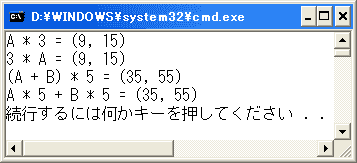
 今回は、前章で作ったMyPositionクラスにスカラー倍を
定義します。スカラーとは大きさだけを持つ普通の数字です。
今回は、前章で作ったMyPositionクラスにスカラー倍を
定義します。スカラーとは大きさだけを持つ普通の数字です。
MyPositionクラスのオブジェクトAが(a,b)で表されるとき、A * nやn * A(nはint型)を定義します。
A * n = (a * n, b * n) n * A = (a * n, b * n)とします。これは、簡単ですね。
// opover02.cs
using System;
class MyPosition
{
int nX, nY;
public int x
{
get
{
return nX;
}
set
{
nX = value;
}
}
public int y
{
get
{
return nY;
}
set
{
nY = value;
}
}
public static MyPosition operator +(MyPosition a, MyPosition b)
{
MyPosition c = new MyPosition();
c.nX = a.nX + b.nX;
c.nY = a.nY + b.nY;
return c;
}
public static MyPosition operator -(MyPosition a, MyPosition b)
{
MyPosition c = new MyPosition();
c.nX = a.nX - b.nX;
c.nY = a.nY - b.nY;
return c;
}
public static MyPosition operator *(MyPosition a, int b)
{
MyPosition c = new MyPosition();
c.x = a.x * b;
c.y = a.y * b;
return c;
}
public static MyPosition operator *(int b, MyPosition a)
{
MyPosition c = new MyPosition();
return a * b;
}
public MyPosition(int m, int n)
{
nX = m;
nY = n;
}
public MyPosition()
{
nX = 0;
nY = 0;
}
}
class opover01
{
public static void Main()
{
MyPosition A = new MyPosition(3, 5);
MyPosition B = new MyPosition(4, 6);
MyPosition C = A * 3;
Console.WriteLine("A * 3 = ({0}, {1})", C.x, C.y);
MyPosition D = 3 * A;
Console.WriteLine("3 * A = ({0}, {1})", D.x, D.y);
MyPosition E = (A + B) * 5;
Console.WriteLine("(A + B) * 5 = ({0}, {1})", E.x, E.y);
MyPosition F = A * 5 + B * 5;
Console.WriteLine("A * 5 + B * 5 = ({0}, {1})", F.x, F.y);
}
}
新たに、演算子のオーバーロードを行っています。
public static MyPosition operator *(MyPosition a, int b)次に、引数の型の順番が逆になっている
public static MyPosition operator *(int b, MyPosition a)も、定義しています。この時a * bもb * aも同じ結果になるので、
public static MyPosition operator *(int b, MyPosition a)
{
MyPosition c = new MyPosition();
return a * b;
}
と、直前の演算子オーバーロードを利用しています。では、実行結果を見てみましょう。

Update 08/Oct/2006 By Y.Kumei